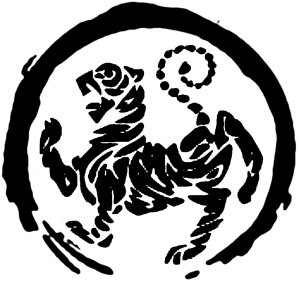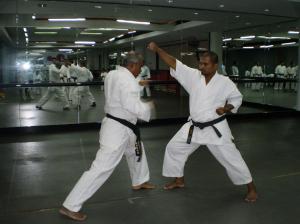How to Choose the Right Dogi
A luxury dogi from one of the major manufacturers is an investment in yourself and your karate. So choosing the correct dogi is extremely important. I assume most people who are considering these dogi have karate experience, and are looking to replace, upgrade or try another brand of dogi.
If you are a beginner (or child) then I recommend starting off with the light beginner dogi and then investing in a more expensive one, once you have decided to continue your training long term.
1. Think about your needs :Think about what the dogi is going to be used for. Purposes include:
- Top level competition i) kata or ii) kumite
-
Kata specific practice
-
Kumite specific practice
-
General purpose for everyday training
-
Summer training in hot climates
-
Winter training in cold climates
|
Weight
|
Purpose
|
|
Heavy weight
|
Good for Kata, instructors, demonstrations, cold conditions, heavy contact training
|
|
Medium weight
|
Good for general purpose everyday training and where comfort and good mobility are required.
|
|
Lightweight
|
Usually beginner suits but also suitable for kumite practice or hot climates
|
|
Super lightweights
|
Ideal for fast action kumite and hot conditions.
|
They can also be divided by material type:
|
material
|
properties
|
|
100% cotton
|
Traditional material used, has advantage of durability, breathability and natural comfort. In my opinion, cooler in summer
|
|
Poly-cotton blends
|
The new age material of dogi offer increased comfort, mobility, sweat absorption / diffusion and easier care.
|
Please note that the material grade or type used may vary between the manufacturers.
2. Decide which brand :Factors to take into account are:
- Purpose
- Brand loyalty
- Price
- Recommendation of others
- Personal preference
3. Decide the size
The most important point here is to read the size charts carefully. Do not just go by your old dogi size, especially if it is a different manufacturer or cut. Also bear in mind that if your current dogi size is now too small, the same size will likely meet the same fate sooner or later. Remember all dogi shrink to some extent so you need to take this into account. (100% Cotton dogi shrink more than poly-cotton dogi.)
My philosophy is that since it is going to shrink, it is always safer to go bigger than smaller as something (adjustments) can be done about a bigger dogi, but if it is too small then it will make a set of very expensive dish-cloths.
4. Decide if you need adjustments or tailoring
Adjustments : As mentioned above getting a bigger size is always safer, however as the arms and legs may be too long, I recommend getting them professionally adjusted by the manufacturer. They make a small charge for this, but it is worth it as they will calculate the length that you will need to take into account for shrinkage. They will also make the stitching perfectly the same as the original.
If you require this service please write down THE FINAL LENGTH (in cm) YOU WANT IT TO BE after shrinkage.
How to measure : Please use an old dogi that you have and measure from the seam to the tip of the cuff for sleeves and from the top of the waist to the tip of the cuff for bottoms. Then make your adjustments based on that. Remember give me the final lengths you want it to be, and the manufacturer will take into account the shrinkage based on the type of dogi.
Tailor-made
Full tailoring is available for all the dogi and you can see that there some exclusive tailor-made dogi.
Points to consider before getting fully tailor made are the extra cost, the extra time it takes and the possibility of errors from your measurements. I usually don’t recommend this option to the average karate-ka unless they have a very disproportionately sized body. However for the elite world level competitor or master then this may be a preference.
About shrinkage
According to the manufacturers:
- 100% cotton dogi tend to shrink about 5-7cm (over a period of 2 years). This measurement is given based on the assumption that you do not hot wash or tumble dry (commercial dryers).
- The poly-cotton blends tend to shrink about 2-3cm (over a period of 2 years). This measurement is given based on the assumption that you do not hot wash or tumble dry (commercial dryers).
5. Decide if you want it personalized.
Most people who invest in a top of the range dogi tend to have it personalized with their name embroidered on. This goes just above the label on the Jacket and next to the label on the bottoms. Embroidery is available in Alphabet, Katakana and kanji.
Not only does this give your dogi a personalized, unique touch, but it looks incredibly good. It also gives it a security feature, should anyone try to claim your dogi!
B. Caring for your dogi
How to take care of your dogi
If you purchase one of these high quality dogi then you can expect quality and durability. However, with proper care you can get many many years of service out of them. Here are a few simple rules to follow in order to get maximum satisfaction from your dogi.
1. Wash your dogi regularly.
Regularly means ideally after every session or realistically after every two or three sessions max.
This is not just for personal hygiene reasons or for the benefit of your co-trainers. Buy not allowing your dogi to become over-soiled, dirty or yellowed with dried in sweat, you will also be able to follow rules number 2, 3 and 4.
2. Do not hot wash your dogi
On the label it says to “COLD WASH ONLY” the dogi. This may not be possible in western machines but use the lowest temperature setting. Not only does this minimize shrinkage but it also minimizes damage to the material. Go easy on the spin cycle. A slower spin is less likely to damage your dogi. If you follow rule number 1 and 4, then hot washing is not necessary.
3. Do not use Bleach
If you follow rule number 1, this should never be necessary. Even blood / soil and other stains can be removed without bleach if it is done right away, rather than allowing it to dry for a long period.
4. Use milder detergents without bleach
If you follow rule number 1 this is very feasible. For stained dogi (eg. blood), I recommend spot removing by hand with a small bit of detergent or for heavy soiling, soaking a few hours in a lukewarm detergent solution, then washing as usual.
5. Do not use fabric conditioner
Fabric conditioner not only blocks the pores in the cotton material thereby locking in dirt and sweat, it also contributes to damaging the fibers of the material. Avoid using it.
6. Do not tumble dry
It clearly says on the label of every dogi “DO NOT USE COMMERCIAL DRYERS” yet people insist on using them. Not only does this shrink the dogi (reducing usable lifespan), but it also damages it such that it gradually becomes stiffer and more likely to rip. Hang dry your dogi (but not in direct sunlight)!
If you really really must use a dryer, then use a big commercial dryer (not home washer /dryers combos) and set it to the delicate setting and dry the dogi alone. Its much better to dry slowly at low temperatures that quickly at scorching temperatures.
7. Wash your dogi separately
If this is possible then I highly recommend it. The more room in your machine, the cleaner it is likely to be. Also there is no chance of colour-run accidents or graying. This may be obvious to most, but never wash your dogi with your belt!
8. If you Iron, do so carefully
There are people who follow the “body iron” rule that during the warm up of a session, their body heat and sweat will self iron the dogi. However, most people prefer to iron. Unfortunately because of the material of many dogi, high temperatures are needed. If possible minimize the temperature you need to use by stretching and flattening the material while it is wet, when you hang it. Hot ironing a damp dogi will make it go yellow.
9. Love your dogi
Independent studies (by a guy named Harry) have shown that the more you love your dogi, the more you are likely to take care of it and the longer it is likely to last.
The only time I would suggest hot washing and tumble drying is if the newly purchased dogi is too large. In this case a few cycles will help the dogi to fit with minumal damage compared to frequent hot wash/tumble drying.
For people who wish to disregard the above advice, then I highly recommend soaking your dogi in acid for a week to speed up the process and them purchasing new ones from me on a regular basis!































